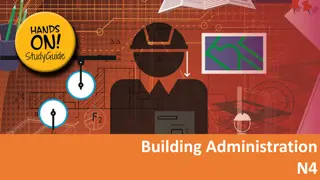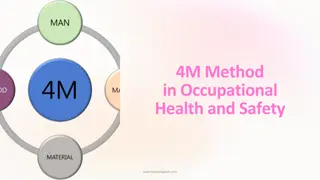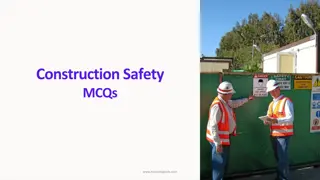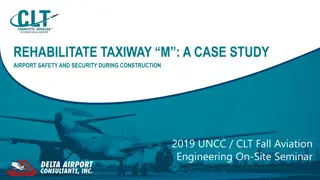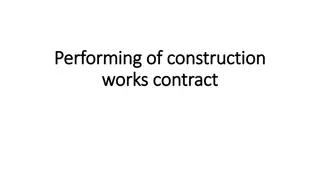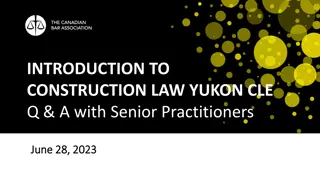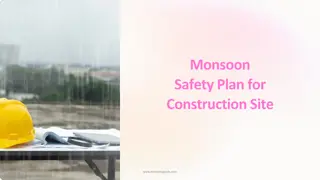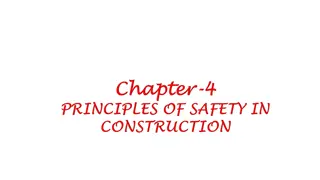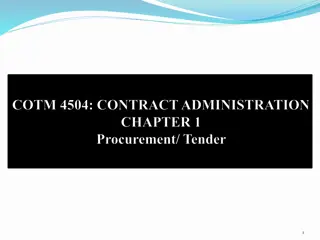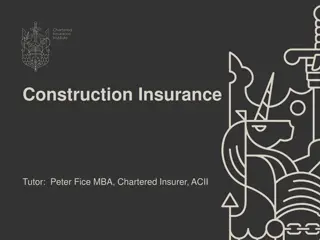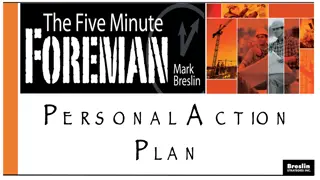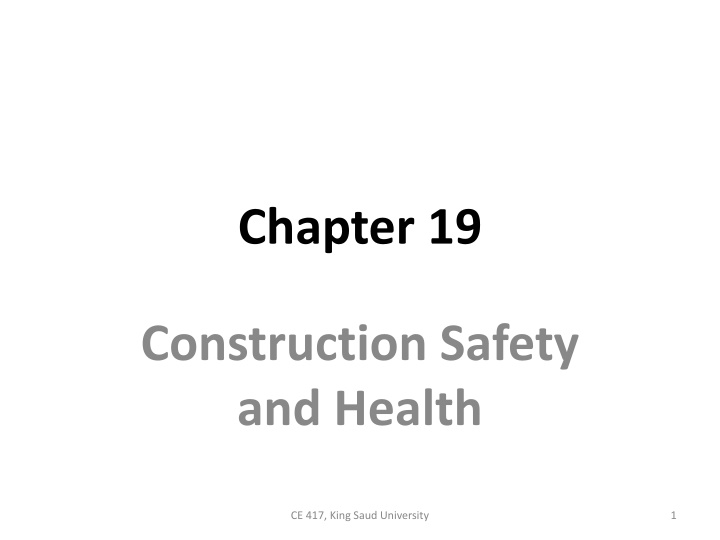
Importance of Safety in Construction: Understanding the Humanitarian and Financial Implications
Learn about the critical importance of safety in the construction industry, as highlighted by the significant impact on work fatalities, injuries, and financial costs. Explore the reasons for prioritizing safety, including humanitarian concerns and the profound financial repercussions of accidents. Discover how safety practices not only protect lives but also safeguard business competitiveness and financial stability.
Download Presentation

Please find below an Image/Link to download the presentation.
The content on the website is provided AS IS for your information and personal use only. It may not be sold, licensed, or shared on other websites without obtaining consent from the author. If you encounter any issues during the download, it is possible that the publisher has removed the file from their server.
You are allowed to download the files provided on this website for personal or commercial use, subject to the condition that they are used lawfully. All files are the property of their respective owners.
The content on the website is provided AS IS for your information and personal use only. It may not be sold, licensed, or shared on other websites without obtaining consent from the author.
E N D
Presentation Transcript
Chapter 19 Construction Safety and Health CE 417, King Saud University 1
Chapter 19 19-1 IMPORTANCE OF SAFETY 19-2 OSHA 19-3 SAFETY PROGRAMS 19-4 SAFETY PROCEDURES 19-5 ENVIRONMENTAL HEALTH IN CONSTRUCTION CE 417, King Saud University 2
19-1 IMPORTANCE OF SAFETY It has been reported that construction, which consists of about 5% of the U.S. work force, accounts for some: 20% of work fatalities and 12% of disabling injuries. The total annual cost (direct and indirect) of construction accidents has been estimated to exceed $17 billion. In the United States, national concern over the frequency and extent of industrial accidents and health hazards led to the passage of the Occupational Safety and Health Act of 1970, which established specific safety and health requirements for virtually all industries, including construction. CE 417, King Saud University 3
19-1 IMPORTANCE OF SAFETY The Occupational Safety and Health Administration (OSHA) is responsible for developing and enforcing regulations implementing this act. the concern over OSHA regulations and penalties has tended to obscure the fact that there are at least two other major reasons for construction management to be seriously concerned about safety. These reasons are: humanitarian and financial. CE 417, King Saud University 4
19-1 IMPORTANCE OF SAFETY Everyone is understandably distressed when a fellow employee is killed or disabled, so the humanitarian basis for safety is apparent. many managers do not fully appreciate the financial consequences of accidents. Worker's compensation insurance premiums, for example, are based on a firm's accident rate. Public liability, property damage, and equipment insurance rates are also affected by accident rates. CE 417, King Saud University 5
19-1 IMPORTANCE OF SAFETY It has been shown that a construction firm can lose its competitive bidding position simply because of the effect of high insurance premiums resulting from a poor safety record. CE 417, King Saud University 6
19-1 IMPORTANCE OF SAFETY In addition to the visible cost of accidents represented by insurance and worker's compensation payments, there are other costs, which are difficult to estimate. Such costs associated with an accident include: the monetary value of lost project time while the accident is investigated and damages are repaired, the time required to replace critical materials and equipment and to train replacement workers, as well as the effect on those portions of the project not directly involved in the accident. CE 417, King Saud University 7
19-2 OSHA The U.S. Occupational Safety and Health Administration (OSHA) has produced a comprehensive set of safety and health regulations, inspection procedures, and record- keeping requirements. The law has also established both civil and criminal penalties for violations of OSHA regulations. Table 19-1 indicates the maximum penalty for major categories of violations. CE 417, King Saud University 8
TABLE 19-1: Maximum penalties under OSHA CE 417, King Saud University 9
19-2 OSHA As shown in Table 19-1, civil penalties of $7000 per day may be assessed for failure to correct a cited violation. Under criminal proceedings, a fine of $20,000 and imprisonment for 1 year may be adjudged for a second conviction of a violation resulting in the death of an employee. OSHA officials may also seek a restraining order through a U.S. District Court to stop work or take other action required to alleviate a condition identified as presenting imminent danger of serious injury or death. CE 417, King Saud University 10
19-2 OSHA Under OSHA regulations employers are required to keep records of all work-related deaths, injuries, and illnesses. It is not necessary to record minor injuries that require only first-aid treatment. all injuries involving medical treatment, loss of consciousness, restrictions on work or body motion, or transfer to another job must be recorded. A special report of serious accidents resulting in one or more deaths or the hospitalization of five or more employees must be made to OSHA officials within 48 hours. CE 417, King Saud University 11
19-2 OSHA One of the major inequities of OSHA is that only management may be penalized for safety violations. So, management may enforce safety regulations is to discipline or fire workers engaging in unsafe acts. It should be pointed out that OSHA safety regulations are considered to be the minimum federal safety standards. CE 417, King Saud University 12
19-3 SAFETY PROGRAMS All construction firms need a carefully planned and directed safety program to minimize accidents and ensure compliance with OSHA and other safety regulations. no safety program will be successful without the active support of top management. Job-site supervisors have traditionally neglected safety in their haste to get the job done on time and within budget. CE 417, King Saud University 13
19-3 SAFETY PROGRAMS Only when supervisors are convinced by higher management that safety is equally as important as production will the benefits of an effective safety program be achieved. An effective safety program must instill a sense of safety consciousness in every employee. CE 417, King Saud University 14
19-3 SAFETY PROGRAMS some of the major elements of safety program are: 1. A formal safety training program for all new employees. 2. Periodic refresher training for each worker. 3. A formal supervisory safety training program for all supervisors. 4. A program of regular site visits by safety personnel to review and control job hazards. 5. Provision of adequate personal protective equipment, first- aid equipment, and trained emergency personnel. 6. An established procedure for the emergency evacuation of injured workers. 7. Provisions for maintaining safety records and reporting accidents in compliance with OSHA requirements. CE 417, King Saud University 15
19-4 SAFETY PROCEDURES It has been found that most serious construction accidents involve: construction equipment operations, trench and embankment failure, falls from elevated positions, collapse of temporary structures and formwork, or the failure of structures under construction. CE 417, King Saud University 16
19-4 SAFETY PROCEDURES Many safety precautions for specific construction operations have been discussed in chapters 18. In addition, the following list of major safety precautions should be helpful as a general guide. CE 417, King Saud University 17
19-4 SAFETY PROCEDURES General Equipment Operations Construction Plant Excavations Construction of Structures Marine or Over-Water Construction CE 417, King Saud University 18
General Good housekeeping on a project site is both a safety measure and an indicator of good project supervision. Lumber, used formwork, and other material lying around a work area increase the likelihood of falls and puncture wounds. CE 417, King Saud University 19
Equipment Operations Require operators and mechanics to use steps and hand holds when mounting equipment. Utilize guides or signalmen when the operator's visibility is limited or when there is danger to nearby workers. Backup alarms or guides must be used when equipment operates in reverse. Exercise extreme caution and comply with safety regulations when operating near high-voltage lines. In case of accidental contact with a high-voltage line, the operator should attempt to move the equipment enough to break contact. If unsuccessful, the operator should remain on the equipment until the line can be deenergized. CE 417, King Saud University 20
Equipment Operations Make sure that machines are equipped with required safety features and that operators use seat belts when provided. Use care when operating equipment on side slopes to prevent overturning. When operating cranes, be extremely careful not to exceed safe load limits for the operating radius and boom position. Electronic load indicators are available. Do not allow workers to ride on equipment unless proper seating is provided. CE 417, King Saud University 21
Equipment Operations Haul roads must be properly maintained. Items to check include: condition of the road surface (holes, slippery surface, excess dust), visibility (curves, obstacles, intersections, and dust), and adequate width for vehicles to pass (unless one-way). CE 417, King Saud University 22
Equipment Operations Park equipment with the brake set, blade or bowl grounded, and ignition key removed at the end of work. Equipment used for land clearing must be equipped with overhead and rear canopy protection. Workers engaged in clearing must be protected from the hazards of irritant and toxic plants and instructed in the first-aid treatment for such hazards. CE 417, King Saud University 23
Equipment Operations When hauling heavy or oversized loads on highways, make sure that loads are properly secured and covered if necessary. Slow-moving and over-sized vehicles must use required markings and signals to warn other traffic. Take positive action to ensure that equipment under repair cannot be accidentally operated. CE 417, King Saud University 24
Equipment Operations Utilize blocking, cribbing, or other positive support when employees must work under heavy loads supported by cables, jacks, or hydraulic systems. Ensure that any guards or safety devices removed during equipment repair are promptly replaced. Shut down engines and do not allow smoking during refueling. CE 417, King Saud University 25
Construction Plant Set equipment containing hot or flammable fluids on firm foundations to prevent overturning. Clearly mark high-temperature lines and containers to prevent burns. Be especially careful of live steam. Provide fire extinguishers and other required safety equipment. CE 417, King Saud University 26
Construction Plant Aggregate bins and batching plants should be emptied before performing major repairs. When electrical equipment is being repaired, shut off and tag electrical circuits. Ensure that wire rope and cable is of the proper size and strength, well maintained, and inspected at least weekly. CE 417, King Saud University 27
Excavations The location of underground utilities and other hazards must be determined before starting an excavation. Contact utility companies and property owners to request that they establish the location of such installations. Almost all U.S. states have central One-Call telephone numbers which coordinate with utility companies to provide prompt service in locating and marking their underground lines when requested. When utility companies or owners cannot provide this information promptly (usually within 24 hours), the contractor may cautiously proceed with excavation. However, in this situation, the contractor must employ detection equipment or other acceptable means to locate and avoid underground hazards. CE 417, King Saud University 28
Excavations The sides of excavations must be properly shored or sloped to the angle of repose to prevent cave-ins. OSHA regulations require that banks over 5 ft (1.5 m) must be shored, cut back to a stable slope, or otherwise protected. Regulations also require that protective systems (sloping, benching, shoring, or shielding) for excavations over 20 ft (6.1 m) deep must be designed by a registered professional engineer. When workers are required to enter a trench excavation 4 ft (1.2192 m) or more in depth, a stairway, ladder, ramp, or other safe means of egress must be located in such a manner as to require no more than 25 ft (7.62 m) of lateral travel by any worker in the trench. CE 417, King Saud University 29
Excavations Avoid the operation of equipment near the top edge of an excavation because this increases the chance of slope failure. The storage of materials near the top edge of an excavation, vibration, and the presence of water also increase the chance of slope failure. When these conditions cannot be avoided, additional measures must be taken to increase slope stability. If workers are required to enter the excavation, no spoil or other material may be stored within 2 ft (0.6 m) of the edge of the excavation. CE 417, King Saud University 30
Excavations Ensure that workers are not allowed under loads being handled by excavators or hoists. Watch out for buried lines and containers when excavating. Possible hazards include toxic and flammable gases, electricity, and collapse of side slopes due to sudden release of liquids. If a gas line is ruptured and catches fire, get personnel and flammable material away from the fire and have the gas turned off as quickly as possible. Do not attempt to extinguish the fire because an accumulation of unburned gas poses a greater threat than does a fire. CE 417, King Saud University 31
Construction of Structures Properly guard all openings above ground level. Provide guard rails, safety lines, safety belts, and/or safety nets for workers on scaffolds or steelwork. Ensure that temporary structures are properly designed, constructed, and braced. CE 417, King Saud University 32
Construction of Structures Special caution should be exercised in high- rise concrete construction. Forms must be of adequate strength and properly braced. The rate of pour must be maintained at or below design limits. Shoring and reshoring must be adequately braced and not removed until the concrete has developed the required strength. CE 417, King Saud University 33
Marine or Over-Water Construction Marine or over-water construction operations present all of the usual construction hazards plus additional hazards posed by the marine environment. These additional hazards include drowning, slippery surfaces, increased tripping and height hazards, as well as weather and wave action. Some of the major safety precautions that should be taken are listed below. Unless workers can safely step onto vessels, a ramp or safe walkway must be provided. Access ways must be adequately illuminated, free of obstructions, and located clear of suspended loads. CE 417, King Saud University 34
Marine or Over-Water Construction Working areas should have nonslip surfaces, be maintained clear of obstructions, and be equipped with adequate handrails. Workers on unguarded decks or surfaces over water must wear approved lifejackets or buoyant vests. Life rings and a rescue boat must also be available. Workers more than 25 ft (7.6 m) above a water surface must be protected by safety belts, safety nets, or similar protective equipment. CE 417, King Saud University 35
19-5 ENVIRONMENTAL HEALTH IN CONSTRUCTION Increased governmental interest in occupational safety has been accompanied by an increased concern for occupational health and environmental controls. The major environmental health problems encountered in construction consist of: noise, dust, radiation (ionizing and nonionizing), toxic materials, heat, and cold. CE 417, King Saud University 36

